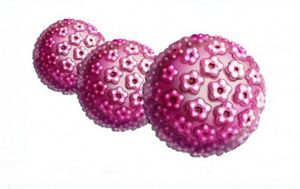
Papillomavirus can remain in the human body for a long time and not manifest itself in any way. It is activated only when the immune system is weakened. In most cases, the infection does not present a particular danger, but some of its strains, under certain factors, can degenerate into oncological diseases. And this already represents a threat to human life. It is impossible to completely get rid of the pathogenic microorganism. Therefore, it is very important to know how the human papillomavirus is transmitted to reduce the risk of HPV infection.
Characteristics of the virus and its transport
The human papillomavirus causes the formation of benign neoplasms on the skin and mucous membranes. They look like a papilla, protruding several millimeters above the surface. As a general rule, this growth appears when the body's defenses are weakened. Usually a person lives quietly and does not even think “can I be a carrier or not? ” At the moment. Why do papillomas form:
- frequent hypothermia or overheating;
- presence of concomitant diseases;
- poor nutrition;
- presence of bad habits;
- frequent stress, depression, overwork;
- lack of vitamins, minerals and other nutrients.
90% of the world's inhabitants are carriers of the papilloma virus. The question immediately arises whether the human papillomavirus is contagious or not. The answer is yes. No one is 100% insured against infection. Therefore, it is very important to know how you can get infected with HPV (human papillomavirus).
How the human papillomavirus is transmitted
Since the probability of contracting HPV is very high, the question often arises as to how the infection (human papillomavirus) is transmitted. Knowing the answer to this question can significantly reduce your risk of infection. Pathogenic microorganisms are transmitted from person to person. These are the most common routes of infection. Infection contact methods:
- Sexually transmitted HPV pathogen (when having sex). Very often, the spread of an oncogenic microorganism occurs in this way. For example, like HPV 16 and 18. Strains of types 16 and 18 are life threatening, as they can degenerate into cancer diseases.
- Contact infection methods. You can infect a person by touching, hugging, or kissing them. The virus enters the body through damage, microcracks in the skin. Therefore, you do not need to come into close contact with people if you notice a wart on your body (if you doubt whether it is contagious).
Transmission paths can also be domestic. How can you get an infection (papilloma) like this:

- through personal hygiene products (towel, cloth, toothbrush, etc. );
- the human papillomavirus can be transmitted through clothing (infection occurs through skin lesions); Infection
- can occur in public baths, saunas (the pathogen can be on the floor, benches, etc. ).
The disease is not inherited. However, a newborn baby can also become infected. How can a baby get papilloma?
- during intrauterine development of an infected mother;
- through the birth canal at the time of birth.
Pregnant women must take great care to avoid infecting or activating a pathogen.After all, not only your health depends on it, but also the life of the baby.
Human papilloma (HPV), how it is transmitted: infection can occur in medical centers, hairdressing salons, beauty salons due to insufficient sterilization of instruments. This happens very rarely, because such institutions, as a rule, meet all sanitary standards, but still there is a place to be.
An infected person may not even know it. Therefore, it is recommended to undergo routine diagnostic tests annually. Now it is clear how the infection occurs. Thanks to this, preventive measures can be taken and infection avoided.
Sexual method
Earlier we found out how you can get infected with a benign neoplasm (papillomavirus). It became clear that most of the time HPV is transmitted through intimacy (sexually). Also, you can get infected with all kinds of sexual intercourse (vaginal, oral, anal).Papilloma through intimate contact (sexually) is transmitted by contact with the mucous membranes, if they are damaged. Also, the risk of infection is higher with anal sex, as it is more traumatic.

Taking into account that during intimate contact the risk of infection increases, the question arises, is it possible to have sex with HPV if a partner has it? Also, during sexual intercourse, infection with oncogenic strains of the virus often occurs.
Sex with HPV is acceptable. But during it, you should always use barrier contraception (condoms). According to statistics, protection helps prevent infection in men and women in 2 out of 3 cases. Without contraception, the risk of infection increases to 90%. If one of the persons entering intimacy is infected, it is necessary to regularly undergo a diagnostic examination to determine the oncogenicity of the pathogen (a healthy partner for the presence of HPV).
However, during sexual intercourse, even with a contraceptive, undesirable phenomena can occur. During sexual intercourse, growth can be injured. As a result, another infection or blood poisoning may occur in the wound. Furthermore, damage to the neoplasm can cause it to degenerate into a malignant one. So it turns out thathaving sex during HPV treatment is not desirable.If so, be very careful. But it is still better to have a connection only after treatment. Sex life after papilloma removal is less risky.
It is believed that the papilloma virus can be activated by masturbation. Apparently, it is an incomplete sexual relationship, as a result of which there is a hormonal alteration and a weakening of the immune system. This opinion is wrong. Masturbation does not affect the protective functions of the body in any way.
For oral sex
HPV can be transmitted from woman to man and vice versa through oral sex. This happens through micro-damage to the skin and mucous membranes. Oral sex is the most common transmission of HPV strains that can turn into cancer.
A condom for oral sex only reduces the risk of infection by giving a blow job. With cunnilingus in 90% of cases, the infection cannot be avoided.
Is the human papillomavirus transmitted from mother to child?
We found out how adults often get infected with the papillomavirus. Now it is necessary to understand if the human papillomavirus is transmitted from mother to child, how it occurs and what is the risk for babies.
In a newborn, infection can occur by touching and kissing the mother, if she is a carrier of the pathogenic microorganism. The infection enters the baby's body through damage to the skin or mucous membranes.
Infection can also occur during fetal development. From an infected woman to her fetus. Also, infection can occur during childbirth. Although rare, it has dire consequences.

Through kiss and blood
How Papilloma Virus Infection Is Also Spread:
- through saliva;
- through a kiss;
- through the blood.
The question arises immediately, if HPV is transmitted through kissing, can you kiss an infected person? This decision is up to you. If you are 100% sure that there is no damage (not even microscopic) to your oral cavity, then kissing is perfectly acceptable. However, this is quite a risky decision. There may be sores in the mouth that you cannot feel and are not even aware of.
The possibility of human papillomavirus infection through blood has not been scientifically proven. There have been cases where an infection occurred during the transfusion.However, this is not evidence that the pathogen can be transmitted in this way.Perhaps the infection in these cases occurred through poorly sterilized instruments.
Home Path
In 85-90% of cases, it is possible to become infected through the home when one of the family members is infected. Household pathogens are often transmitted from parents to children. The child's immunity is still fragile, and therefore the baby is more susceptible to infections. Domestic infection can occur as follows:
Household pathogens are often transmitted from parents to children. The child's immunity is still fragile, and therefore the baby is more susceptible to infections. Domestic infection can occur as follows:
- if there is skin damage, infection can occur from the use of shared bedding, towels, washcloths, soap, cosmetics, and hugs;
- through saliva, you can become infected by using a plate, a toothbrush, kissing with a virus carrier;
- when wearing the clothing of an infected person (especially underwear);
- in a home environment, self-infection may occur during shaving or waxing.
Furthermore, infection in public places is a common way of transmission of the pathogen. For example, in the pool, steam room, sauna. And also with frequent handshakes and friendly hugs.
How not to get infected with the papilloma virus
How not to get HPV (human papillomavirus):
- avoid frequent changes of sexual partners;
- protect yourself during privacy;
- not to use other people's things;
- don't wear other people's clothes;
- avoid visiting public baths, saunas, swimming pools (or at least bring a personal towel, changeable shoes);
- do not drink or eat food from infected people;
- carefully approach the choice of cosmetology, clinic, hairdresser (you need to make sure that all sterilization rules are observed in the institution);
- Do not come into close contact with carriers of the virus.
If you develop papillomas, see your doctor. He will carry out the necessary diagnostics, determine the strain of the pathogen and, if necessary, prescribe effective treatment.
Does the condom protect?
If one of the partners has HPV, it is necessary to use a condom during sexual intercourse. However, a contraceptive is not a 100% guarantee that the infection will not be transmitted. Of course, the pathogenwill not be able to get through the condom, but infection can occur in a different way.
Infection can occur with foreplay. Through microcracks in the skin or in the mouth. In this case, a barrier contraceptive will not save.
Treatment methods
If you are a carrier of HPV, the infection can lie dormant in your body and not cause any problems.To prevent growths on the body, you need to monitor the state of your immune system.The stronger it is, the lower the risk of neoplasm formation.
If growths occur, your doctor may advise you not to take any action (as long as the papillomas do not cause discomfort and do not have an oncogenic strain). If the decision was made to get rid of neoplasms, then, as a rule, this is done by conservative methods. If drug treatment does not give a therapeutic result or there is a risk of papilloma degeneration in an oncological disease, surgical intervention is prescribed (if there are no contraindications for this).























